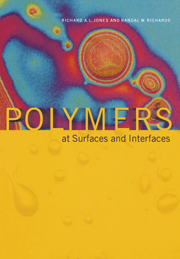Book contents
- Frontmatter
- Contents
- Preface
- 1 Introduction and overview
- 2 The surface of a simple polymer melt
- 3 Experimental techniques
- 4 Polymer/polymer interfaces
- 5 Adsorption and surface segregation from polymer solutions and mixtures
- 6 Tethered polymer chains in solutions and melts
- 7 Adhesion and the mechanical properties of polymer interfaces at the molecular level
- 8 Polymers spread at air/liquid interfaces
- Index
5 - Adsorption and surface segregation from polymer solutions and mixtures
Published online by Cambridge University Press: 19 January 2010
- Frontmatter
- Contents
- Preface
- 1 Introduction and overview
- 2 The surface of a simple polymer melt
- 3 Experimental techniques
- 4 Polymer/polymer interfaces
- 5 Adsorption and surface segregation from polymer solutions and mixtures
- 6 Tethered polymer chains in solutions and melts
- 7 Adhesion and the mechanical properties of polymer interfaces at the molecular level
- 8 Polymers spread at air/liquid interfaces
- Index
Summary
Introduction
If we study the composition of the surface of a polymer solution or a polymer mixture we should expect to find that the composition of the region near the surface is not the same as that of the bulk. The same applies to an interface between such a system and a solid; for example a colloidal particle suspended in a polymer solution will often be coated with a layer of polymer, that may well be able to stabilise the colloid, preventing its aggregation. In polymer solutions this phenomena is known as adsorption, if the polymer accumulates at the surface, or depletion, if it is the solvent that is favoured there; in polymer blends one often refers to the surface segregation or surface enrichment of one component of the mixture. However, these different names describe what is essentially the same phenomenon, the subject of this chapter.
Segregation phenomena are universal in mixed systems; the surface of a mixture of small-molecule liquids will usually be enriched in the species of low surface energy and the surface composition of a metallic alloy will rarely be the same as the bulk composition. However, mixtures containing polymers are special in two ways. Rather large degrees of segregation or adsorption can be obtained even when the interaction driving the segregation is small; offset against any gain in energy obtained on adsorption is a loss of translational entropy of the molecule in the bulk, but for a large molecule this entropy is rather small.
- Type
- Chapter
- Information
- Polymers at Surfaces and Interfaces , pp. 187 - 243Publisher: Cambridge University PressPrint publication year: 1999
- 1
- Cited by



